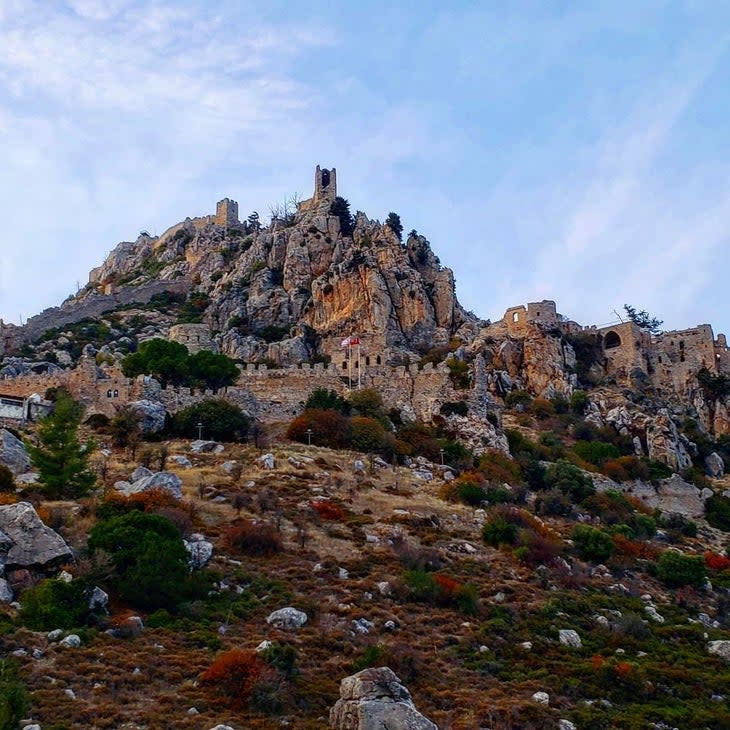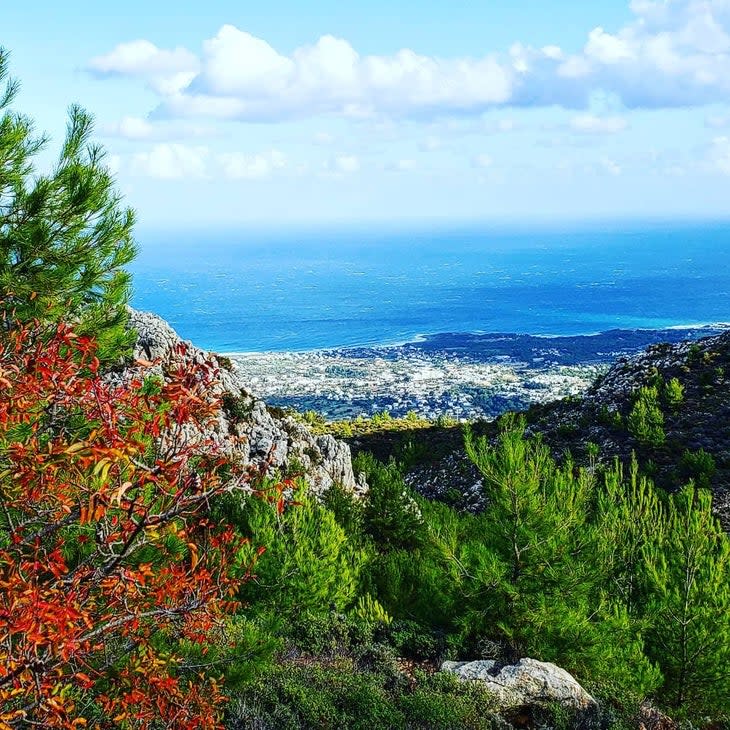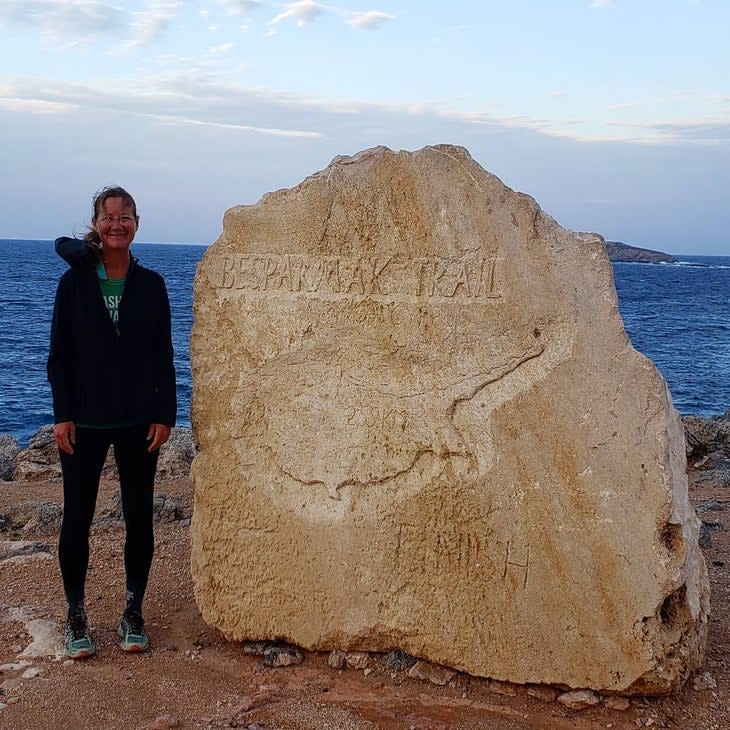Running at the Edge of Europe
This article originally appeared on Trail Runner
Dusk was settling on the Besparmak Trail, a 158-mile route that follows the eponymously named mountain range in Northern Cyprus. The peaks that stretched out around me were tinged with the rosy golden light of the sinking sun, and in the distance I could see the surface of Dagdere Lake shimmering. It would have been one of those perfect moments of tranquility in nature, a oneness with the delight of solitude in the wilderness.
Except I was lost.
It had already been an arduous November day, having struck out at dawn from the city of Guzelyurt and arriving at Cape Kormakitis via a bizarre amalgamation of trail running, road running, and hitchhiking with Turkish rabbit hunters. I was on the second section of the trail, 13 miles connecting Korucam and Lapta, when I somehow veered off course.
I was relying heavily on screenshots of a trail map I'd found online from a 2018 FKT attempt by ultrarunner Brandon Chase. With some experience running longer trails on my home turf of Kaua'i along with treks in Nepal, New Zealand, Greece, and the Alps, I had foolishly decided to try to match Chase's five-day completion.
With darkness approaching, having not seen a trail marker for at least an hour, I absconded to Google Maps and decided to take the paved road the remaining few miles to Lapta.

I was achingly close to civilization when several armed members of the Turkish military emerged from a building that lay starkly between me and town.
"No pass!" yelled one with a stern look. I tried to convey that I was lost and indicated the trail on my phone, attempting my most deferential plea to just allow me to pass to the road (and restaurant) one block away. I was firmly rebuffed, sent back up the mountain on a route that would add over eight miles in near darkness. I'd been on the move for twelve hours.
RELATED: Why Do So Many Thru-Hikers Become Trail Runners?
After research, I had some grasp of Cyprus's geopolitical divide since the Turkish invasion in the early 1970s. My understanding was that since Northern Cyprus isn't recognized by the European Union as a separate country, it would just be a section of Cyprus mainly occupied by Turks, with all the obvious differences in culture and language that that implies.
I learned this wasn't the case as I crossed the border on foot between Kato Pyrgos, the last village on the Greek side, to the Yesilirmak crossing that leads to the Turkish side. I was allowed to cross the first border with little fanfare, other than a peremptory glance at my passport and COVID vaccination.
But when I arrived on the Turkish side, the border guard was decidedly less congenial. He seemed skeptical of my intentions, insisting that I needed a current COVID test and vaccination card, which hadn't been the case in Greece or Greek Cyprus.
With not much to do other than take a deep breath and smile, I turned around and ran back to Kato Pyrgos.
The following day, COVID test in hand, I repeated the procedure. Ironically, the guard the second morning on the Turkish side was not only friendly, he didn't even open the folded paper I handed him containing my test results.
Upon arrival in Yesilirmak, the sense of having crossed into a different country became apparent. Orthodox churches changed to mosques, gyros stands changed into kebab shops, and prices listed in Euros switched to Turkish lira. The sound of the Muslim call to prayer echoed through the valleys, and the smell of grilled meats, cumin, and oregano drifted from roadside stalls. Strawberry fields lined the roadside and date palms dropped their fruit in sweet profusion.

When I arrived in Lapta that first night, it was well after dark. I had walked and run well over 50K. I stopped at the first establishment I saw that looked like it might serve food and sat down to order a glass of wine and chips. I found accommodations nearby, had an incredible Turkish meze, and slept for twelve hours.
Over the next five days on the trail, I encountered stunning vistas and challenging ascents. I became lost on scree slopes and in vast swathes of thorn bushes. I slept in a monastery and above a cafe in Kantara, in the apartment of the Ukrainian woman who ran the restaurant. It was freezing, and we huddled in front of a blazing fire drinking vodka and eating chocolate after she cooked me a feast. I was her sole customer the entire evening.
RELATED: Trail Running The Wild And Rugged Faroe Islands
Nearing the Edge
The last day of my running trek, three miles from the end of the route at Cape Zafer, my knee started to act up. I was in a very rural area and had only seen one car pass in the last few hours. I knew I could make it to the trailhead, but I was concerned about getting the next five miles to the nearest village. When I got to the trailhead I nearly forgot all my pain and exhaustion in the sheer rush of completing the journey.
The wind was whipping across the sea at this, the easternmost edge of Cyprus and, thus, Europe itself. The Turkish flag flashed on the rocky precipice by the trailhead, a vibrantly colored symbol of the turbulent history between the Greeks and the Turks. A car was parked along the seaside, and I could see three people picking their way over the rocks and taking pictures. I felt confident I could get a lift with them, as I'd experienced unswerving hospitality throughout the Northern Cypriot countryside.
As I took my own pictures of the coastline, enamored by its end-of-the-earth wildness, I was distracted enough that I didn't notice the car pulling away. I hobbled frantically behind, yelled, waved my arms, but to no avail. I watched, dejected, as solitude and dusk approached once again.
And so, I began the long trudge to the closest sign of civilization, the Sea Bird Motel. I hadn't had a hot shower in several days, and I felt an ache that went deeper than my muscles and tendons, an ache that permeated my entire body and maybe even my soul. Steinbeck said, "All great and precious things are lonely." Gandhi, too: "It's easy to stand in the crowd, but it takes courage to stand alone."
RELATED: 3 Ways To Crush Your First 100 Miler
It was in this moment of sad resignation that a car pulled up, going the opposite direction. The brakes slammed, the windows rolled down, and three smiling faces of young Turkish men beamed at me.

"Calamari!", one yelled joyfully.
They remembered me from the restaurant where we had all eaten dinner in Lapta, five days prior, 100 miles earlier. It was quickly decided that I would watch the sunset with them and catch a lift all the way back to Kyrenia, almost ninety miles to the west.
As I drifted off to sleep that night on clean, crisp white sheets in a hotel in Kyrenia, I thought about the trail, the mountains, the journey, and the history. Most of all, I thought about all the benevolence that had been shown to me by everyone, from the rabbit hunters to the young Turkish engineers who rescued me from Cape Zafer. These were the experiences that made me fall in love with traveling in my early twenties: connections forged under strange circumstances, despite barriers of language and culture.
As we attempt to emerge from the economic and social spiral caused by the COVID pandemic, and as political tensions remain high in Turkish-occupied Northern Cyprus, there was still something so comforting about being back on my feet again, traveling past wild donkeys and a brilliant sunset, surrounded and held by the kindness of strangers.
Julia Reynolds is a freelance writer and bartender based on the north shore of Kaua'i. Her hobbies include getting lost, breaking bones, and taking thousands of pictures of sunsets.

For exclusive access to all of our fitness, gear, adventure, and travel stories, plus discounts on trips, events, and gear, sign up for Outside+ today.

